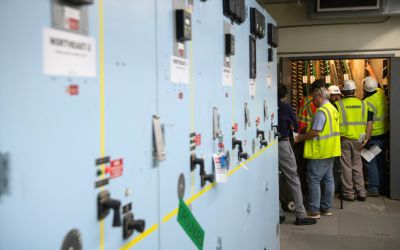Underground Fire Highlights Power of UMB Microgrid Plan
In the early hours of Aug. 10, the University of Maryland, Baltimore (UMB) power grid was put to the test.
About 3 a.m., alert Operations and Maintenance workers saw thick smoke and flames shooting from a manhole on South Greene Street. They immediately sprang into action notifying managers, the fire department, and BGE.

Contractors and the UMB Operations and Maintenance team in the S. Greene Street switching station.
“We have a crew on site 24/7,” explains Melissa A. Morland, MS, MBA, RBP, CBSP, executive director for Facilities Operations and Maintenance Administration. “They were walking by and saw the manhole cover had slipped. They reported the fire and they called the assistant director for electrical trades, Brian Croston.”
A duct bank collapse and underground utility fire on South Greene Street caused electrical outages to several buildings on UMB’s campus including the School of Social Work, Howard Hall, and the Bressler Research Building, endangering the campus community as well as priceless research.
Croston remembers the 3:30 a.m. call that jolted him awake that summer morning. “I got dressed and rushed out the door and started calling my people to get in and figure out what was going on,” says Croston. His entire team including high-voltage technicians and the entire electronics shop responded to the call. “There was a lot of concern that we had a really big problem.”
And it was a really big problem. The Bressler Research Building houses priceless irreplaceable tissue samples and genetic material used for research in oncology, pediatrics, neurology, OB/GYN, emergency medicine, trauma, pharmacology, microbiology and immunology, and cardiology.
“The freezers were our biggest concern,” says Croston. “We had freezer rooms that were heating up and we had to keep the ventilation going."
Fortunately for UMB, the campus is several years into the Campus-Wide Electrical Distribution Project — an electrical upgrade project that started in 2014 and will essentially create a UMB microgrid to replace aging infrastructure and reduce reliance on BGE. The three-phase project with an estimated budget of $85 million consists of a North Station at the UMB Recycling Center, a South Station behind the Health Sciences and Human Services Library, and duct bank construction connecting buildings to the new switching stations.
The upgrade of the campus’ electrical distribution system will provide reliability and help UMB meet today’s demands while also building in additional capacity for the future. The original scope of work is expected to be completed by fall 2027, though additional follow-up work will extend to 2029.
The microgrid project grew out of a now-infamous electrical grid failure on Thanksgiving Eve in 2011 when a faulty roof drain leaked into the Greene Street master switching station causing an explosion that took out electricity across campus. “This was 24 hours before Thanksgiving,” said Mike Krone, MS, UMB assistant director, utilities management. “It caused a lot of drama.”
The Thanksgiving incident, followed by another failure two years later, prompted Croston’s predecessor and senior management to begin plans for additional switching stations to provide redundancy to the electrical grid to avoid future campuswide failures.
Noting the 60-year-old clay pipes and cracked walls underground, Krone credits the visionary planners of the microgrid initiative with their forward thinking. “They were very wise people. They asked for more than they needed to ensure it covered any black swan events or unexpected circumstances," he says.
Without the work of this multiyear electrical distribution project, UMB would have had to dig up several streets throughout campus to run new duct and make repairs to damaged feeds after the August incident. That work would have taken weeks, as Bressler combated warming tissue samples and remained dependent on backup generators that burned 1,000 gallons of fuel every 24 hours.
Instead, Cianbro — the electrical firm working on the project — fast-tracked commissioning the complete but not fully commissioned North Station. By Aug. 14, it was online and feeding electricity to Bressler. “It felt good,” Croston recalls. “It took a lot of hurdles to get there, but it felt good once we got there.”
Morland credits the microgrid plan as well as UMB teamwork including the Office of Emergency Management, Environmental Health and Safety, the School of Medicine, and many others with helping to avert what could have been a huge disaster. “Our team is always putting out fires on a regular basis although not necessarily actual fires,” she says, laughing. “Everyone worked well in a stressful situation. They were amazing, the camaraderie, the teamwork. They worked perfectly under pressure.”



